Articles
- Page Path
- HOME > J Korean Acad Nurs > Volume 43(1); 2013 > Article
-
Original Article
- Analysis of the Characteristics of the Older Adults with Depression Using Data Mining Decision Tree Analysis
- Myonghwa Park, Sora Choi, A Mi Shin, Chul Hoi Koo
-
Journal of Korean Academy of Nursing 2013;43(1):1-10.
DOI: https://doi.org/10.4040/jkan.2013.43.1.1
Published online: February 28, 2013
1College of Nursing, Chungnam National University, Daejeon, Korea.
2Kyungpook National University Medical Center, Chilgok-gun, Gyeongbuk, Korea.
3Department of Public Administration, Cheongju University, Chungbuk, Korea.
- Address reprint requests to: Park, Myonghwa. College of Nursing, Chungnam National University, 55 Munhwa-ro, Jung-gu, Daejeon 301-747, Korea. Tel: +82-42-580-8328, Fax: +82-42-580-8309, mhpark@cnu.ac.kr
© 2013 Korean Society of Nursing Science
Abstract
-
Purpose
- The purpose of this study was to develop a prediction model for the characteristics of older adults with depression using the decision tree method.
-
Methods
- A large dataset from the 2008 Korean Elderly Survey was used and data of 14,970 elderly people were analyzed. Target variable was depression and 53 input variables were general characteristics, family & social relationship, economic status, health status, health behavior, functional status, leisure & social activity, quality of life, and living environment. Data were analyzed by decision tree analysis, a data mining technique using SPSS Window 19.0 and Clementine 12.0 programs.
-
Results
- The decision trees were classified into five different rules to define the characteristics of older adults with depression. Classification & Regression Tree (C&RT) showed the best prediction with an accuracy of 80.81% among data mining models. Factors in the rules were life satisfaction, nutritional status, daily activity difficulty due to pain, functional limitation for basic or instrumental daily activities, number of chronic diseases and daily activity difficulty due to disease.
-
Conclusion
- The different rules classified by the decision tree model in this study should contribute as baseline data for discovering informative knowledge and developing interventions tailored to these individual characteristics.
This research was supported by the Basic Science Research Program through the National Research Foundation of Korea (NRF) funded by the Ministry of Education, Science and Technology (2010-0024922).
- 1. Alexopoulos GS. Depression in the elderly. Lancet. 2005;365(9475):1961–1970. http://dx.doi.org/10.1016/s0140-6736(05)66665-2.ArticlePubMed
- 2. An JY, Tak YR. Depressive symptoms and related risk factors in old and oldest-old elderly people with arthritis. J Korean Acad Nurs. 2009;39(1):72–83. http://dx.doi.org/10.4040/jkan.2009.39.1.72.ArticlePubMed
- 3. Bae JN, Cho MJ. Development of the Korean version of the Geriatric Depression Scale and its short form among elderly psychiatric patients. J Psychosom Res. 2004;57(3):297–305. http://dx.doi.org/10.1016/j.jpsychores.2004.01.004.ArticlePubMed
- 4. Bae WS, Cho DH, Seok KH, Kim BS, Choi KL, Lee JE, et al. Data mining using SAS enterprise miner. 2004;Seoul, Kyowoosa.
- 5. Choi JH, Kang HC, Kim ES, Lee SK, Han ST, Kim MK. Prediction and excess of data mining using decision tree analysis. 2002;Seoul, SPSS Academy.
- 6. Chou KL, Chi I. Prevalence and correlates of depression in Chinese oldest-old. Int J Geriatr Psychiatry. 2005;20(1):41–50. http://dx.doi.org/10.1002/gps.1246.ArticlePubMed
- 7. Fayyad UM, Piatetsky-Shapiro G, Smyth P, Uthurusamy R. Advances in knowledge discovery and data mining. 1996;Cambridge, MA, MIT Press.
- 8. Furman EF. Undernutrition in older adults across the continuum of care: Nutritional assessment, barriers, and interventions. J Gerontol Nurs. 2006;32(1):22–27.Article
- 9. Health Insurance Policy Research Institute National Health Insurance Coporation. The press release. 2011;Retrieved May 2, 2012. from http://www.nhic.or.kr/portal/site/main/menuitem.31f14893bf4f6c8b31148b4062310a0/.
- 10. Huh J, Jeong KS, Huh SH, Choi HK. Clementine 7 manual. 2003;Seoul, Data Solution.
- 11. Huh MH, Lee YG. Data mining modeling and case. 2008;2nd ed. Seoul, Hannarae.
- 12. Jeon YJ. A study on variable selection methods in the efficacy test of drugs - comparison of statistical and data mining methods. 2003;Seoul, Yonsei University. Unpublished master's thesis.
- 13. Jeong HK. Development of model for preventing informally discharged cancer patients using medical records in an university hospital. 2004;Daejeon, Chungnam National University. Unpublished master's thesis.
- 14. Kang JS, Chung YS. The influences of physical health, cognitive symptom and nutritional status on the depression of the elderly dwelling in a big city. J Korean Acad Community Health Nurs. 2008;19(3):378–387.
- 15. Kim DB, Sohn ES. A meta-analysis of the variables related to depression in elderly. J Korean Gerontol Soc. 2005;25(4):167–187.
- 16. Koivumaa-Honkanen H, Kaprio J, Honkanen R, Viinamäki H, Koskenvuo M. Life satisfaction and depression in a 15-year follow-up of healthy adults. Soc Psychiatry Psychiatr Epidemiol. 2004;39(12):994–999. http://dx.doi.org/10.1007/s00127-004-0833-6.ArticlePubMedPDF
- 17. Lee SH, Oh KO. Disability, depression and social support in older adults with osteoarthritis. Chungnam J Nurs Acad. 2008;11:13–21.
- 18. Maas ML, Delaney C. Nursing process outcome linkage research: Issues, current status, and health policy implications. Med Care. 2004;42:2 Suppl. II40–II48. http://dx.doi.org/10.1097/01.mlr.0000109291.44014.cb.PubMed
- 19. Mecocci P, Cherubini A, Mariani E, Ruggiero C, Senin U. Depression in the elderly: New concepts and therapeutic approaches. Aging Clin Exp Res. 2004;16(3):176–189.ArticlePubMedPDF
- 20. Mills TL. Comorbid depressive symptomatology: Isolating the effects of chronic medical conditions on self-reported depressive symptoms among community-dwelling older adults. Soc Sci Med. 2001;53(5):569–578. http://dx.doi.org/10.1016/S0277-9536(00)00361-0.ArticlePubMed
- 21. Ministry of Health & Welfare. 2008 National survey on the elderly. 2009;Retrieved May 1, 2012. from http://stat.mw.go.kr/front/statData/publicationView.jsp?menuId=41&bbsSeq=7&nttSeq=12031&searchKey=&searchWord=&nPage=3.
- 22. Moon MJ. Factors influencing depression in elderly people living at home. J Korean Acad Nurs. 2010;40(4):542–550. http://dx.doi.org/10.4040/jkan.2010.40.4.542.ArticlePubMed
- 23. Park YH, Suh EE. The risk of malnutrition, depression, and the perceived health status of older adults. J Korean Acad Nurs. 2007;37(6):941–948.ArticlePDF
- 24. Rajkumar AP, Thangadurai P, Senthilkumar P, Gayathri K, Prince M, Jacob KS. Nature, prevalence and factors associated with depression among the elderly in a rural south Indian community. Int Psychogeriatr. 2009;21(2):372–378. http://dx.doi.org/10.1017/s1041610209008527.ArticlePubMedPMC
- 25. Sok SR, Kim KB. Effects of muscle electric stimulation on chronic knee pain, activities of daily living, and living satisfaction for korean elderly women. J Korean Acad Nurs. 2007;37(3):305–312.ArticlePDF
- 26. Song MS, Kim SK, Kim NC. Factors influencing depression among rural elders. J Korean Gerontol Nurs. 2010;12(1):21–28.
- 27. Statistics Korea. Population projection for Korea: 2010-2060. 2012;Daejeon, Statistics Korea.
- 28. Suhn MO, Chae YM, Lee HJ, Lee SH, Kang SH, Ho SH. An application of datamining approach to CQI using the discharge summary. Proceedings of the Korea Inteligent Information System Society Conference. 2000;2:289–299.
- 29. Yesavage JA, Brink TL, Rose TL, Lum O, Huang V, Adey M, et al. Development and validation of a geriatric depression screening scale: A preliminary report. J Psychiatr Res. 1982;17(1):37–49. http://dx.doi.org/10.1016/0022-3956(82)90033-4.PubMed
- 30. Yim ES, Lee KJ. Effect of physical ability, depression and social support on quality of life in low income elders living at home. J Korean Gerontol Nurs. 2003;5(1):38–49.
- 31. Yoon SJ, Lee YH, Son TY, Oh HJ, Han GS, Kim KH. Factors associated with dementia and depressive symptoms in older persons living in the community. J Korea Gerontol Soc. 2002;21(3):59–73.
REFERENCES
Figure & Data
REFERENCES
Citations

- Attribution analysis and forecast of salinity intrusion in the Modaomen estuary of the Pearl River Delta
Qingqing Tian, Hang Gao, Yu Tian, Qiongyao Wang, Lei Guo, Qihui Chai
Frontiers in Marine Science.2024;[Epub] CrossRef - A prediction model for adolescents’ skipping breakfast using the CART algorithm for decision trees: 7th (2016–2018) Korea National Health and Nutrition Examination Survey
Sun A Choi, Sung Suk Chung, Jeong Ok Rho
Journal of Nutrition and Health.2023; 56(3): 300. CrossRef - Development of a prediction model for the depression level of the elderly in low-income households: using decision trees, logistic regression, neural networks, and random forest
Kyu-Min Kim, Jae-Hak Kim, Hyun-Sill Rhee, Bo-Young Youn
Scientific Reports.2023;[Epub] CrossRef - A Predictive Model of Ischemic Heart Disease in Middle-Aged and Older Women Using Data Mining Technique
Jihye Lim
Journal of Personalized Medicine.2023; 13(4): 663. CrossRef - A Comparative Study of Predictive Factors for Passing the National Physical Therapy Examination using Logistic Regression Analysis and Decision Tree Analysis
So Hyun Kim, Sung Hyoun Cho
Physical Therapy Rehabilitation Science.2022; 11(3): 285. CrossRef - Occupational accident prediction modeling and analysis using SHAP
Hyung-Rok Oh, Ae-Lin Son, ZoonKy Lee
Journal of Digital Contents Society.2021; 22(7): 1115. CrossRef - FACTORS DETERMINING THE EXTENT OF GDPR IMPLEMENTATION WITHIN ORGANIZATIONS: EMPIRICAL EVIDENCE FROM CZECH REPUBLIC
Adam Faifr, Martin Januška
Journal of Business Economics and Management.2021; 22(5): 1124. CrossRef - Evaluation of Food Labeling Policy in Korea: Analyzing the Community Health Survey 2014–2017
Heui Sug Jo, Su Mi Jung
Journal of Korean Medical Science.2019;[Epub] CrossRef - Factors Influencing Depression in Middle Aged Women: Focused on Quality of life on Menopause
Jung Nam Sohn
Journal of Health Informatics and Statistics.2018; 43(2): 148. CrossRef - Song-Induced Autobiographical Memory of Patients With Early Alzheimer's Dementia
Seung Ah Han
Journal of Music and Human Behavior.2016; 13(2): 49. CrossRef - Factors Affecting on Life Satisfaction of Elderly after Total Knee Arthroplasty
You-Jin Park, Eun-Hee Park
Journal of Digital Convergence.2016; 14(9): 563. CrossRef - Application of big data analysis with decision tree for the foot disorder
Jung-Kyu Choi, Keun-Hwan Jeon, Yonggwan Won, Jung-Ja Kim
Cluster Computing.2015; 18(4): 1399. CrossRef - A Study on Comparison of Classification and Regression Tree and Multiple Regression for Predicting of Soldiers' Depression
Chung Hee Woo, Ju Young Park
Journal of Korean Academy of Psychiatric and Mental Health Nursing.2014; 23(4): 268. CrossRef - Knowledge Discovery in a Community Data Set: Malnutrition among the Elderly
Myonghwa Park, Hyeyoung Kim, Sun Kyung Kim
Healthcare Informatics Research.2014; 20(1): 30. CrossRef - The predictability of dentoskeletal factors for soft-tissue chin strain during lip closure
Yun-Hee Yu, Yae-Jin Kim, Dong-Yul Lee, Yong-Kyu Lim
The Korean Journal of Orthodontics.2013; 43(6): 279. CrossRef - Some fixed point theorems in locally p-convex spaces
Leila Gholizadeh, Erdal Karapınar, Mehdi Roohi
Fixed Point Theory and Applications.2013;[Epub] CrossRef - Factors Influencing Depressive Symptoms in Community Dwelling Older People
Jung Nam Sohn
Journal of Korean Academy of Psychiatric and Mental Health Nursing.2013; 22(2): 107. CrossRef

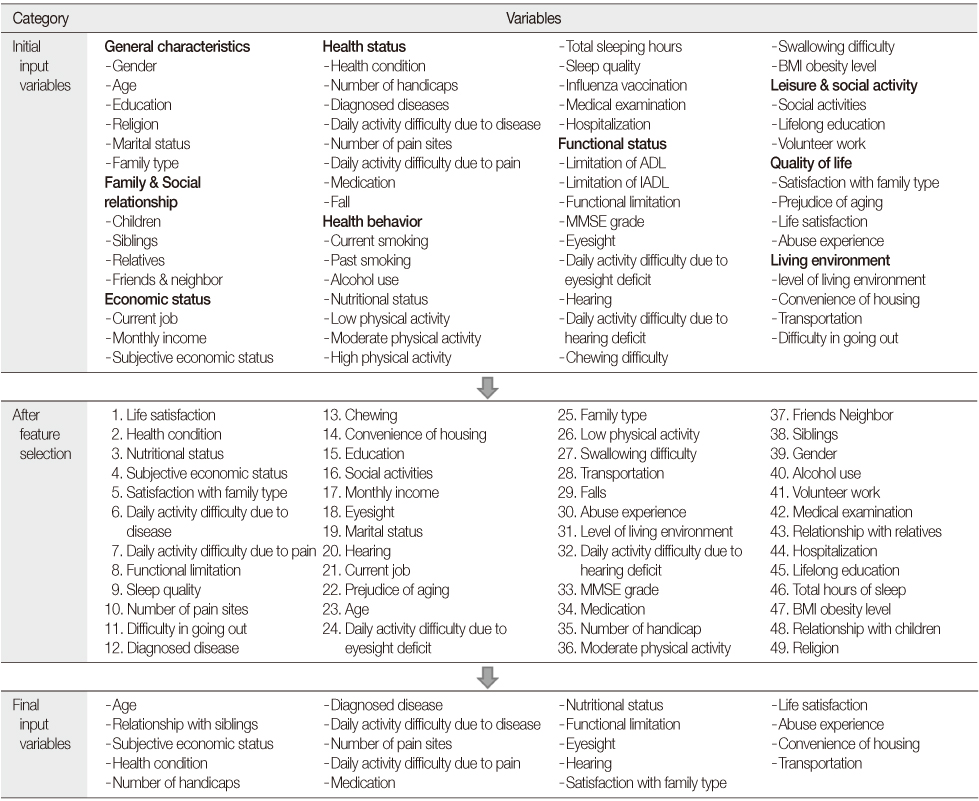
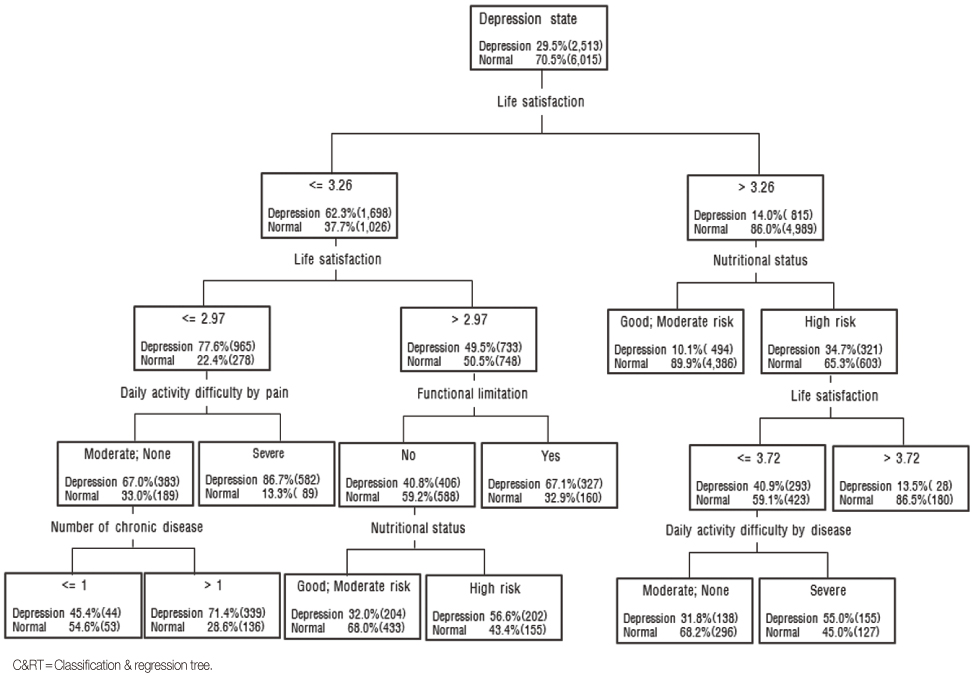
Figure 1
Figure 2
Figure 3
Predictive Performance according to Modeling Methods
C&RT=Classification & regression tree; QUEST=Quick, unbiased, efficient, statistical tree; CHAID=CHi-squared automatic interaction detection.
General Characteristics of Participants (N=14,970)
C&RT=Classification & regression tree; QUEST=Quick, unbiased, efficient, statistical tree; CHAID=CHi-squared automatic interaction detection.
 KSNS
KSNS
 E-SUBMISSION
E-SUBMISSION
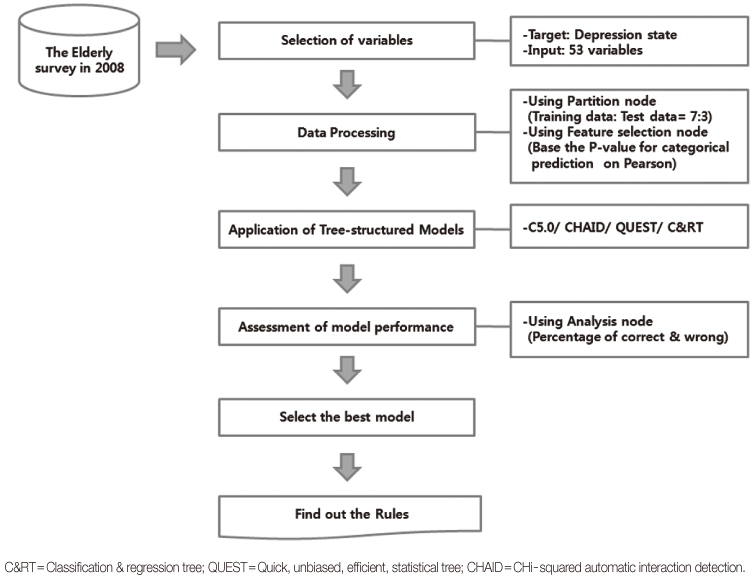


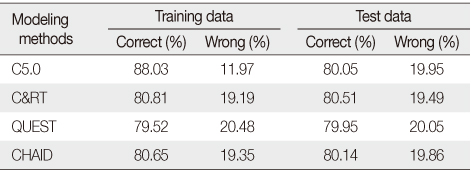
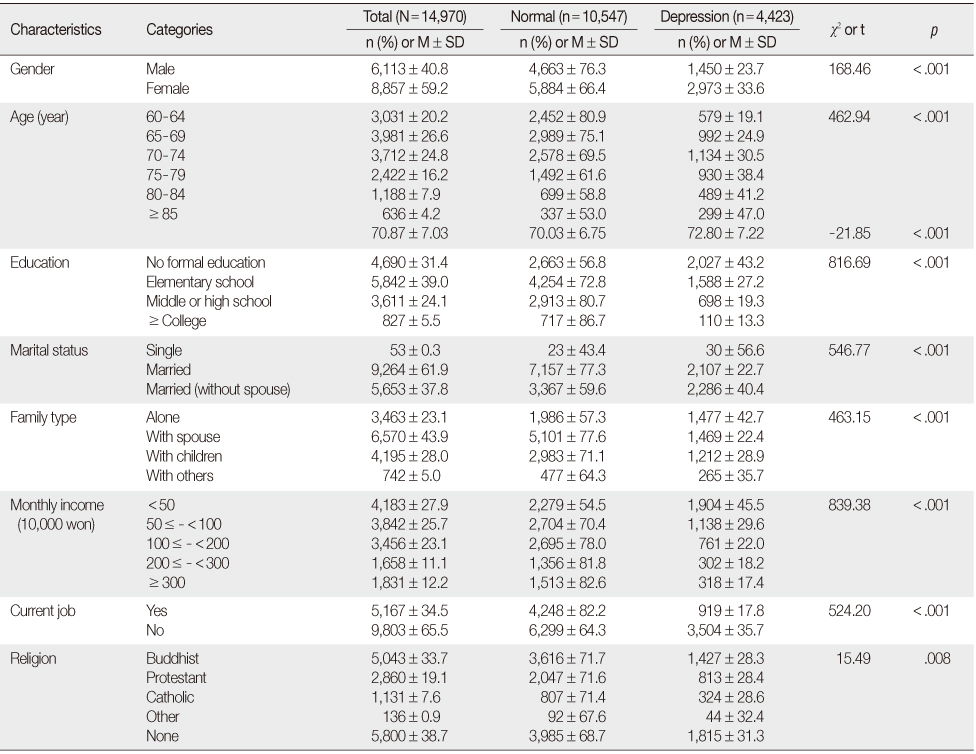
 Cite
Cite

